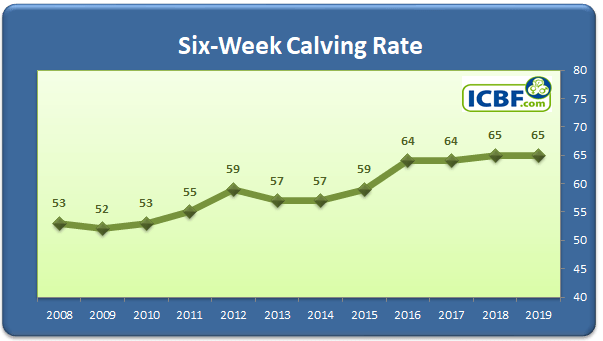As autumn is upon us and the HerdPlus Dairy calving reports have been generated for all farmers we can present the national Dairy calving statistics for 2020 (1st January – 30th June). These statistics give a great insight into the fertility performance of the national herd and allow us to assess the progress being made in reproductive performance.

Table 1. shows the key performance indicators for the national average as well as the top and bottom 10% of herds. The average calving interval is 387 days while the top 10% achieved a calving interval of 364 days, which is surpassing the target of 365 days. The calving interval is a key parameter for measuring the fertility performance of a herd and to see herds achieving calving intervals under 365 days highlights the progress herds have made in fertility.

Figure 1. shows the national average calving intervals from 2009 to 2020. It is very positive to see the trend in the graph which highlights the improving fertility of the national herd. Given the low heritability of fertility it is very encouraging to see that the emphasis on fertility in the EBI is paying off with the improving performance in the country. The top 10% highlights the potential gains that can be made in fertility despite the low heritability. With the national average sitting at 387 days there is plenty scope to continue make more improvements in fertility. The trend over time emphasises that continuing to select high EBI bulls is key to making further progress.

When we look at the at the 6 weeks calving rate (Figure 2), we also see a similarly positive trend to what we see in the calving interval with the 6-week calving rate going from 53% in 2009 to 65% in 2020. For the top 10% the 6-week calving rate is 86% which is close to the Teagasc target of 90%.
Interestingly when we look at the % of heifers calved with 22-26 months of age the top 10% are achieving 100% calved while the national average is sitting at 71%. Some believe that calving heifers older will mean they will perform better and be more profitable. ICBF research has shown that calving heifers at 22-26 months of the age is the optimum in terms of maximising profitability of the animals. The survival rate is highest in animals calved at 22-26 months of age and in turn they achieved an additional 71kg of milk solids over their lifetime.
Looking at the progress over time in some of the other KPI’S we have seen Calves/cow/year go from 0.84 in 2009 to 0.91 in 2020, it is also positive see less cows being recycled with 13% of cows being recycled compared to 18.7% in 2009. In the top 10% of herds were seeing no cows being recycled at all. Recycling cows reduces empty culling rate in the short term but there is hidden costs to this policy including lost milk yield, slippage in calving pattern and fewer replacement heifers produced. This combined with the cost of feeding these recycled cows suggests that avoiding recycling cows is very beneficial.

The use of the EBI has resulted in significant progress being made in the fertility sub index which can be seen in the 2020 calving statistics as well as the trends we have seen over time. There are still considerable opportunities to improve and this can be maximised by using high EBI genomic and daughter proven bulls with high fertility sub-indexes.
For a detailed breakdown of the 2020 calving statistics click here
